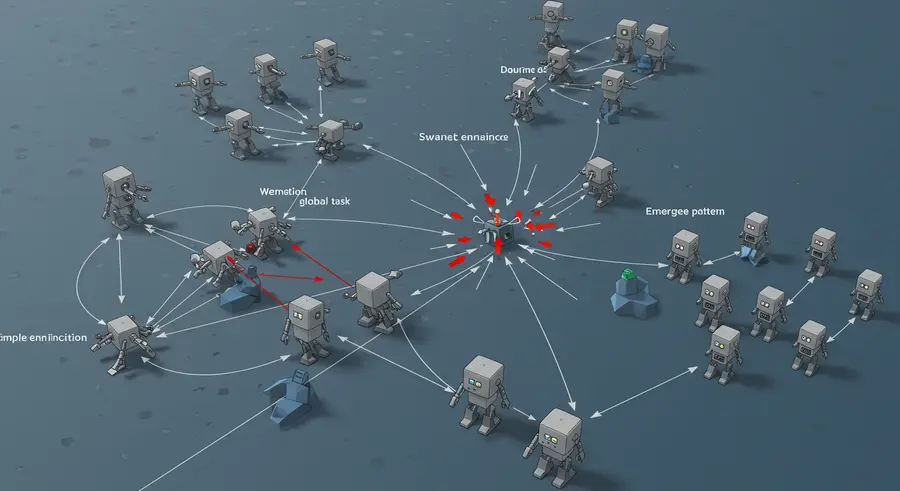Appearance
Swarm Intelligence: The Power of Collective Action in Robotics
The natural world is full of incredible examples of collective intelligence: ants building intricate nests, birds flocking in mesmerizing patterns, or fish schooling to evade predators. These aren't led by a single mastermind; instead, complex behaviors emerge from simple, local interactions among individuals. This fascinating concept is what drives "swarm intelligence," and it's revolutionizing the field of robotics.
What is Swarm Intelligence?
At its core, swarm intelligence is about achieving complex global tasks through the decentralized and self-organized interactions of many simple agents. In robotics, this means using a group of robots, often identical and with limited individual capabilities, that communicate and react to their immediate environment and each other. The "brain" isn't in one central unit, but distributed across the entire swarm.
Think of it this way: a single ant isn't very smart, but an ant colony can find the shortest path to food, build complex structures, and defend its territory. Similarly, a single swarm robot might only have basic sensors and movement, but a swarm of them can collectively map an area, transport large objects, or perform intricate construction tasks.
Key characteristics of swarm intelligence in robotics include:
- Decentralization: No single robot is in charge. Decisions are made locally by individual robots based on their limited information.
- Self-organization: Complex patterns and behaviors emerge from simple rules and local interactions, without explicit programming for the global outcome.
- Robustness: If one or more robots fail, the swarm can often continue its mission due to the redundancy of agents.
- Scalability: The system's performance can often improve by simply adding more robots, making it suitable for large-scale operations.
- Flexibility: Swarms can adapt to changing environments and unforeseen obstacles more readily than rigid, centrally controlled systems.
Here's a visual representation of how simple local interactions can lead to complex emergent behavior in a swarm:

Mimicking Nature's Masterpieces: Algorithms in Action
Many swarm intelligence algorithms are directly inspired by biological phenomena:
- Particle Swarm Optimization (PSO): Mimics the social behavior of bird flocks or fish schools, where individuals adjust their movement based on their own best-found position and the best position found by the entire group. This is often used for optimization problems.
- Ant Colony Optimization (ACO): Inspired by ants finding the shortest path between their nest and a food source by depositing pheromones. Robots can simulate these "scent trails" to find optimal routes or perform collective tasks like image segmentation.
- Bee Colony Optimization (BCO): Based on the foraging behavior of honeybees, used for optimization and task allocation.
A stunning real-world example of swarm intelligence in action is drone light shows. Thousands of drones, each acting as a simple agent, communicate locally to form intricate patterns and animations in the sky. There's no central controller dictating every drone's movement; instead, the collective behavior emerges from their local interactions.
Real-World Applications: Where Swarms Shine
Swarm robotics isn't just for research labs; it holds immense potential across various industries, especially where tasks are dangerous, repetitive, or require high adaptability:
- Environmental Monitoring: Swarms of aquatic drones (USVs and UUVs) can monitor water quality, detect oil spills, and map underwater environments much more efficiently than single, larger vehicles. Similarly, UAV swarms can inspect vast agricultural fields for crop health or weed detection.
- Construction: Imagine robots collaborating to build structures or anchor foundations without detailed blueprints, adapting to terrain and material availability like a colony of termites. This is already being explored for complex construction tasks.
- Logistics and Warehousing: In automated warehouses, swarms of robots can optimize material transport and order fulfillment, dynamically re-routing and collaborating to pick and move items. Companies like Amazon and Alibaba already use thousands of robots in their fulfillment centers, demonstrating the efficiency of multi-robot systems.
- Search and Rescue: Swarms of small robots, terrestrial or aerial, can navigate hazardous or collapsed environments to locate survivors, provide communication relays, or map dangerous zones, minimizing risk to human rescuers.
- Space Exploration: Given the extreme and unpredictable nature of space, swarms of small, autonomous robots could explore distant planets, assemble structures in orbit, or extract resources, offering redundancy and adaptability far beyond a single rover. NASA's "Marsbees" concept envisions tiny flapping-wing robots exploring Mars.
The Path Forward: Challenges and Opportunities
While the potential is vast, transitioning swarm robotics from research to widespread industrial deployment faces challenges:
- Predictability and Reliability: Emergent behavior, while powerful, can be hard to predict and guarantee in complex real-world scenarios. Ensuring safety and reliability is paramount, especially in applications involving human interaction or critical infrastructure.
- Communication Robustness: Swarms rely heavily on robust, local communication. In noisy or obstructed environments, maintaining seamless interaction among hundreds or thousands of robots is a significant hurdle.
- Human-Swarm Interaction: Designing intuitive ways for humans to interact with and oversee swarms, providing high-level goals without micromanaging individual robots, is crucial for adoption.
- Regulatory Frameworks: As autonomous robot swarms become more common, new regulations and ethical considerations need to be developed.
Despite these challenges, the unique advantages of swarm intelligence—adaptability, robustness, and scalability—make it a compelling solution for problems that are currently difficult or impossible for single robots or centrally controlled systems. The ongoing research and increasing industry interest signal a future where miniature, collaborative robots, inspired by nature's wisdom, play a transformative role in our world.
The journey of unlocking the full potential of collective intelligence in artificial systems is just beginning, and it promises to be as fascinating as the natural phenomena that inspire it.